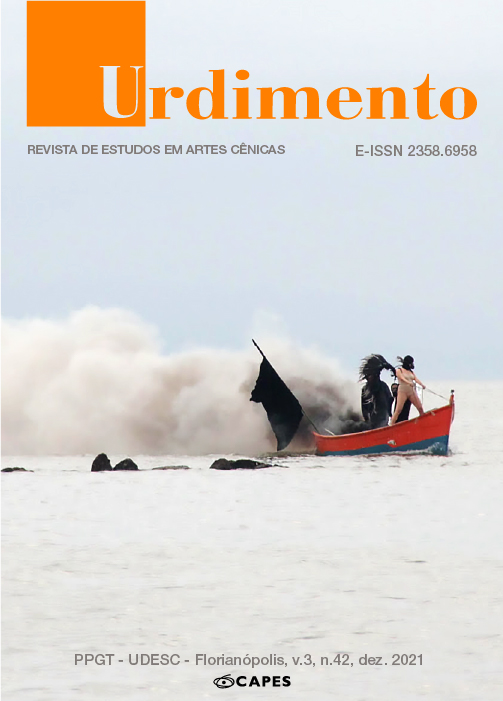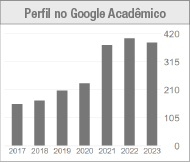The intimate scene in a remote university research and extension project
DOI:
https://doi.org/10.5965/1414573103422021e0114Keywords:
Immersion theater, Intimate scene, Remote creative process, University outreachAbstract
The notions of immersion theatre, intimate scene, neo-technological theater and audio-theater permeate a path in research and university extension that started before, but continued during the Covid-19 pandemic. The intimate scene is a scenic format that favors the encounter, sensory immersion and processes of disorientation regarding space, time and presence. The measures of social isolation and the implementation of remote emergency academic activities led to a specific context of creative experimentation, in which elements of the intimate scenic format were reinterpreted based on the limitations and potential of telematic and virtual presences. Despite the distinctions between theatrical experiences (in person) and remote artistic experiences, technological mediations are adopted in this project as devices to imagine a possible remote intimate scene and produce multiple records of the creative process.
Downloads
References
CASIRAGHI, Mauricio Pezzi. Insônia: A tecnologia audiovisual como catalisadora para a imersão no teatro. Dissertação (Mestrado em Artes Cênicas) - Universidade Federal do Rio Grande do Sul, Porto Alegre, 2017.
CORREIA, Eliana Rosa; SANTOS, Gleiziane Pinheiro dos. O rádio-teatro no ensino remoto: um experimento artístico-pedagógico. Rebento, São Paulo, n. 13, p.325-346, jul. - dez 2020. Disponível em:
http://www.periodicos.ia.unesp.br/index.php/rebento/article/view/596. Acesso em: 14 jun. 2021.
DINIZ, Liana Ferraz; GOUSSINSKY, Sônia. A voz em (instabilidade de) rede. Rebento, São Paulo, n. 13, p.285-303, jul. - dez 2020. Disponível em http://www.periodicos.ia.unesp.br/index.php/rebento/article/view/584. Acesso em: 14 jun. 2021.
DUBATTI, J. Convivio y tecnovivio: el teatro entre infancia y babelismo. Revista Colombiana de las Artes Escénicas, v. 9, p.44-54, 2015.
DUBATTI, Jorge. Experiência Teatral, experiência tecnovivival: nem identidade, nem campeonato, nem melhoria evolutiva, nem destruição, nem laços simétricos. Rebento, São Paulo, n. 12, p. 8-32, jan. -jun. de 2020.
GÓMEZ, Máximo José; DIP, Nerina Raquel. Da contenção à criação: experiência artístico-pedagógica na pandemia. Tradução: Simone Carleto. Rebento, São Paulo, n. 13, p. 139-163, jul. - dez 2020. Disponível em http://www.periodicos.ia.unesp.br/index.php/rebento/article/view/603. Acesso em: 14 jun. 2021.
SCHECHNER, Richard. Environmental theater. New, expanded ed. New York: Applause, 1994.
PAVIS, Patrice. A análise dos espetáculos: teatro, mímica, dança, dança-teatro, cinema. Tradução: Sérgio Sálvia Coelho. São Paulo: Perspectiva, 2011.
PÉDICO, André Leme; MACHADO, Fabiana de Sousa Cunha; SOUZA, Leandro Pereira de. As Oficinas "Paisagem Sonora - Sons e Silêncios da Quarentena": relato de experiência realizada na Mostra Virtual de Artes do CEFET-MG. Rebento, São Paulo, n. 13, p. 304-324, jul. - dez 2020. Disponível em: http://www.periodicos.ia.unesp.br/index.php/rebento/article/view/594. Acesso em: 15 jun. 2021.
SOLANO, Iara. Formato Cênico Intimista. Entrevista cedida a Bianca Nascimento de Melo. Palmas (TO), 12 ago. 2020. Transcrita em anexo do relatório final do projeto de iniciação científica: Processo de criação em cena intimista: narrativas de uma artista-pesquisadora em formação, pela Universidade Federal do Tocantins (UFT, 2019-2020).
SPRITZER, Mirna. O exercício radiofônico como prática da palavra, da vocalidade e da escuta. Urdimento – Revista de Estudos em Artes Cênicas, Florianópolis, v. 1 n. 22, p. 89-98, julho de 2014.
Disponível em:
https://www.revistas.udesc.br/index.php/urdimento/article/view/1414573101222014089/3178. Acesso em: 14 jun. 2021.
Downloads
Published
How to Cite
Issue
Section
License
Copyright (c) 2021 Urdimento - Revista de Estudos em Artes Cênicas

This work is licensed under a Creative Commons Attribution 4.0 International License.
Copyright Statement
The articles published by the magazine are free to use. The copyright is all assigned to the magazine. The articles whose authors are identified represent the expression from the point of view of their authors and not the official position of the journal Urdimento. The author (s) undertakes whenever publishing material relating to the article published in Revista Urdimento mention the said publication as follows: This article was originally published by Urdimento magazine in its volume (put the volume), number (put the number) in the year of (put the year) and can be accessed at:
http://www.revistas.udesc.br/index.php/urdimento
This work is licensed under a Creative Commons Attribution 4.0 International License.




